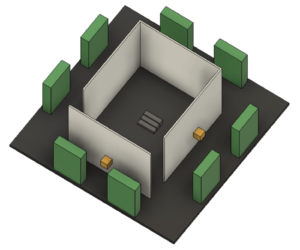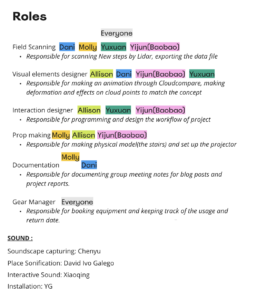A place is a location with unique identity and social meaning, while a non-place is an anonymous and impersonal space lacking in identity and social significance.
– ChatGPT
This page presents a written proposal of the envisioned project for the means of the Digital Media Studio Project (2022-2023) course at Edinburgh College of Arts. The project results from the collective authorship of a team of post-graduate students composed of five Digital Design Media students and four Sound Design students, all undertaking the respective post-graduate programs. For this project, the concept of “place” was underlined as the foundation topic of the project.
The philosophical pursuit of defining “place” took over the first weeks of development. Along with extensive research, discussion and reasoning behind this concept, the project collective understands “place” as a dynamic perception of reality that results from the culmination of common yet specific factors. Two of these are understood as “space” and “time”, which following today’s metaphysical reasoning, have an interdependent and unique relationship that provides the very existence of the other defining factors. Another crucial factor is perspective, being the one to question if a specific place is real or abstract, to scope it under the layers of reality, and to bring one-selves consciousness into experience of a place.
Having established a common notion of the formulation of “place”, the developments moved on to reflecting ways of synthesising a place that emphasises its conceptual foundations, following the factors described above.
The use of LiDAR technology was the first agreement to fall into place, as this allowed capture of the “space” factor with high fidelity, yet independent of its natural dynamic with the “time” factor, something the project could now re-synthesise and explore without temporal continuity as a constraint.
Later the exhibition in an immersive format was agreed into plans, as this blends the existing place where the exhibition would exist, and a newly conceptualised one, creating a new and unique place altogether. The exhibition format of the immersive kind also allows the project to explore the “perspective” factor directly within the user’s self-consciousness. One must be in the space to experience it. It is then self-perspective that conceives the notion of place, having the individual not as a mere spectator of a place but instead part of it.
With this project, we aim to explore the connection and transition between a liminal place and the audience by creating a unique, fully immersive experience.
The described aims will be achieved by collecting data through LiDAR scans, field recordings, Arduino systems and AI-generated content. Process and synthesis will be performed through cloud point visualisation software, Max/Msp and C# scripts. Finally, presented through means of multi-dimensional projection and surround sound displacement.
It will be presented in the Atrium of Alison House
In very simple terms:
This is an exploration though time and space, based on The News Steps in Edinburgh. Users are surrounded by 4 back-lit projector screens whose content reflects the respective view of the LiDAR scanner (front, back, left, right) starting at the bottom of the News Steps. Speakers are placed around the room for surround sound. A staircase of 3 steps sits in the middle of the room. The middle of these steps is the neutral starting point; when user is on the top step, the images and sound morph forward and upwards through time. The reverse happens when they move to the lowest step. On each landing of the stairs, a snippet of narrative can be seen and heard.


The specific aspects of this project has been divided into organised blog posts for each section. In these posts, in addition to the relevant content, you will find the research and reasons for decisions the team has made regarding the construction and conception of this brief.
The order of reading is as follows:
Background Research and Context
Individual project ideas – feel free to read through all of these to explore our thoughts. Find these below.
YG – Preparation of Surround Sound Production
Roles

Description of sound roles: The Sound Task Force
Individual project ideas
Molly Munro
Daniela Morales
David Amado
Yijun Zhou
Allison Mu
Yuxuan Guo
Xiaoqing Xu
Yuanguang Zhu
Chenyu Li